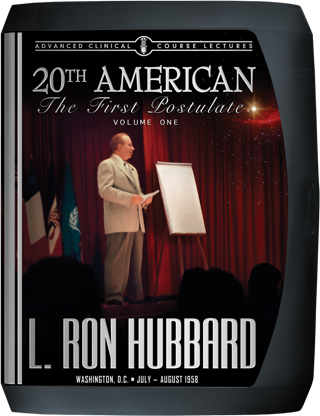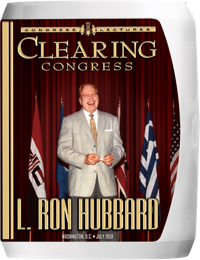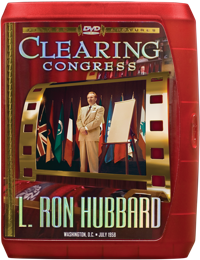- 繁體中文 | Chinese
- Dansk | Danish
- Deutsch | German
- English | English
- Ελληνικά | Greek
- Español (Latino) | Spanish
- Español (Castellano) | Castilian
- Français | French
- עברית | Hebrew
- Italiano | Italian
- 日本語 | Japanese
- Magyar | Hungarian
- Nederlands | Dutch
- Norsk | Norwegian
- Português | Portuguese
- Русский | Russian
- Svenska | Swedish
Publisher of New York Times and International Bestselling Author L. Ron Hubbard
20th American ACC
The First Postulate

20th American ACC
The First Postulate
Having announced the fact of clearing at the Clearing Congress, L. Ron Hubbard now devoted the 20th American ACC to a comprehensive restatement of fundamentals. Telling students, “In every single advance of Dianetics or Scientology we have moved from being able to help the few to being able to help the many,” Mr. Hubbard taught how to clear the many. It began with the technology to evoke preclear participation—namely, in‑sessionness. With mishandled origins the largest cause of preclears going out of session, he detailed how to ensure they stay in session. And that was far from all, for here is a wealth of new material—an explanation of auditing the Rock, an incident at the core of the reactive mind, a description of the Atom, an engram preceding The Factors, and the presentation of crucial discoveries on meter phenomena. With auditors drilled till they knew their data cold, L. Ron Hubbard made the 20th ACC the standard for professional auditor training. While toward that goal of clearing the many, Scientology expansion mushroomed even as he embarked for England to announce the next advance in the name of broad clearing—one that harked back to the earliest days of Dianetics.
Read MoreMore About 20th American ACC
We can now say that a few hundred, certainly a few thousand Clears are within view. A hundred thousand could change the civilization of Earth.
We’re on our way. —L. Ron Hubbard
With the completion of the 19th Advanced Clinical Course, L. Ron Hubbard had achieved a goal set even before publication of Dianetics: The Modern Science of Mental Health. For while auditors had always been able to produce miracle results on preclears, he had now so refined the technology that any well-trained auditor could consistently make a Clear. If the point has previously been made, it bears repeating: From as early as 1947, Mr. Hubbard had always been capable of making Clears. Thus, ever since the day Dianetics hit the bookstores and soared onto bestseller lists, his foremost aim had been to develop processes that others—auditors all over the world—could apply, to any preclear, to accomplish that same result: Clear.
And now, in 1958, the years of steady and often dramatic advance had culminated in the long-sought goal resoundingly achieved with the making of 15 Clears in student auditing given on a course where even all supervision had been by Instructors other than Mr. Hubbard—the 19th ACC.
The moment was historic and the triumph was celebrated at the Clearing Congress where, in a series of truly momentous lectures, L. Ron Hubbard announced to exuberant Scientologists that broad scale clearing was now a reality. Today, those lectures stand as the only Congress recorded on film and, hence, where one can both hear and see the announcement of the fact of clearing.
With clearing now an accomplished fact, Mr. Hubbard devoted the 20th American Advanced Clinical Course in Washington, DC, to a comprehensive restatement of the very fundamentals of auditing from the perspective of all that had been learned in those intense years of research and discovery. In other words, not merely what process to run and why, but something even more basic—the skill and technical application required of an auditor to evoke from the preclear the willingness to be audited and their full participation in the session—namely, in-sessionness:
“Boy, is auditing effective if they’re really in session. And boy, is it ineffective if they’re not. Now, what’s a PT problem but that activity going on in the physical universe at this moment which permits a preclear’s attention to be exterior to the session and exterior to the auditor and therefore not upon the problem of auditing.
“If you don’t think this is serious, watch profiles before and after twenty-five hours of expert, excellent, professional auditing on a pc who, all that time, had a PT problem that wasn’t touched and that he never told the auditor about and that remained masked and buried. You get no change of profile, no change of IQ, no vanishment of psychosomatics or anything else.
“Now, that tells you how important that in-sessionness is. Pretty important, if it can keep every process run from working. So therefore it must be senior to every process run.”
Thus, an array of tools for auditors to accomplish the prerequisite of every session: the pc willing to be there, willing to be audited and willing to follow the auditor’s commands. Yet that was far from all, for L. Ron Hubbard additionally instructed those auditors on a wide array of new breakthroughs and discoveries. Case in point: entire lectures devoted to handling the Rock, defined by Mr. Hubbard as the core of the Reactive Mind. Then there was the engram common to all thetans, the Atom, with Mr. Hubbard’s additional description of how it preceded The Factors. Here, too, was his further explanation of the use of the E-Meter and crucial discoveries on needle reactions: the first description of a Rock Slam, the origin of the Stage Four needle and the exact theory and mechanics of what was to become the renowned E-Meter Drill 16, The Production of Needle Actions. All these and a host of related technical applications, every one of them fundamental:
- First Postulate—Not-knowingness is the common denominator to not-clearness, since the preclear’s solution to the basic problems of pain and unconsciousness was to not-know it;
- Clearing—the heart of clearing is the principle that destruction is totally dependent on the constructiveness that preceded it. Addressing constructiveness alone banishes destructiveness;
- Change, Problems, Help, Create and Responsibility—the five buttons found in all aberration, which must be addressed to make a Clear;
- The Auditor—how the auditor is the “god” of the preclear’s time track and the “professional privacy invader”;
- Auditor Interest—the woof and warp of auditing depends on the auditor’s interest;
- Origins—more preclears go out of session because of mishandled origins than for any other reason;
- Case Progress—how to monitor it with scales and testing;
- Education—it is education that makes the OT.
With those auditors taught and drilled until they could chant the basics in their sleep, the course proved so successful that L. Ron Hubbard would establish the 20th ACC as the standard for Professional Auditor training.
And with auditor skills having reached a new plateau, resulting in Clears being made routinely, the resulting dissemination and reach for Scientology accelerated to unprecedented levels. From Perth, Australia, came news of 100 students on an introductory course, another 90–100 on an advanced course, a dozen study groups run by auditors in the field and the organization flooded with phone calls from interested people. Simultaneously, in Greece, Scientology: The Fundamentals of Thought had been translated, making the Book One of Scientology available to the inheritors of the world’s great philosophers. And all the while, thousands of Dianetics continued to leap off the shelves, with a quarter of a million copies sold of the hardback edition and publishers now engaged in discussions with Mr. Hubbard to bring out a first paperback edition to meet public demand. And yet more—films of the Clearing Congress lectures hitting the road for a 27-city tour throughout the United States and later in Britain, all proving so popular that people traveled from neighboring towns to attend screenings while they, in turn, trained on the latest technology, so beginning the cycle anew in their locales.
Yet, if that was the pulse of Scientology expansion across the world as the fall of 1958 approached, there was yet everything this new technical plateau would further bring. In fact, L. Ron Hubbard was already preparing to board the RMS Statendam, bound for London. There, not only would he give his most renowned lecture ever in the famed Royal Empire Society Hall, his visit would mark the release of yet another milestone breakthrough—an advance that would hearken back to the earliest days of Dianetics.

